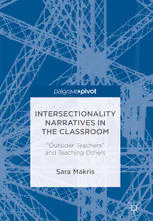
Intersectionality Narratives in the Classroom: “Outsider Teachers” and Teaching Others PDF
Preview Intersectionality Narratives in the Classroom: “Outsider Teachers” and Teaching Others
INTERSECTIONALITY NARRATIVES IN THE CLASSROOM “Outsider Teachers” and Teaching Others Sara Makris Intersectionality Narratives in the Classroom Sara Makris Intersectionality Narratives in the Classroom “ ” Outsider Teachers and Teaching Others SaraMakris IndependentScholar UniversityPark,MD USA ISBN978-3-319-67446-9 ISBN978-3-319-67447-6 (eBook) https://doi.org/10.1007/978-3-319-67447-6 LibraryofCongressControlNumber:2017954219 ©TheEditor(s)(ifapplicable)andTheAuthor(s)2018 Thisworkissubjecttocopyright.AllrightsaresolelyandexclusivelylicensedbythePublisher, whetherthewholeorpartofthematerialisconcerned,specificallytherightsoftranslation, reprinting,reuseofillustrations,recitation,broadcasting,reproductiononmicrofilmsorinany otherphysicalway,andtransmissionorinformationstorageandretrieval,electronicadaptation, computersoftware,orbysimilarordissimilarmethodologynowknownorhereafterdeveloped. Theuseofgeneraldescriptivenames,registerednames,trademarks,servicemarks,etc.inthis publicationdoesnotimply,evenintheabsenceofaspecificstatement,thatsuchnamesare exemptfromtherelevantprotectivelawsandregulationsandthereforefreeforgeneraluse. Thepublisher,theauthorsandtheeditorsaresafetoassumethattheadviceandinformationin thisbookarebelievedtobetrueandaccurateatthedateofpublication.Neitherthepublisher northeauthorsortheeditorsgiveawarranty,expressorimplied,withrespecttothematerial contained herein or for any errors or omissions that may have been made. The publisher remains neutral with regard to jurisdictional claims in published maps and institutional affiliations. Coverillustration:DétaildelaTourEiffel©nemesis2207/Fotolia.co.uk Printedonacid-freepaper ThisPalgraveMacmillanimprintispublishedbySpringerNature TheregisteredcompanyisSpringerInternationalPublishingAG Theregisteredcompanyaddressis:Gewerbestrasse11,6330Cham,Switzerland ToDaniel. A CKNOWLEDGMENTS Thisbookwouldnothavebeenpossiblewithoutthegenerosityandopen- ness of the research participants. It would also not exist without the guid- ance and support of the faculty, staff, and students in the University of MarylandMinorityandUrbanEducationprogram.Thankyou. vii C ONTENTS 1 Introduction:“OutsiderTeachers”andtheCase forIntersectionality 1 2 TheRoleofNarrative 13 3 TeacherNarrative:Jamie 23 4 TeacherNarrative:Maria 33 5 TeacherNarrative:Lisa 43 6 TeacherNarrative:Winnie 53 7 TeacherNarrative:Kyong 63 8 Conclusion:LessonsLearnedandImplications forFutureScholarship 71 Index 85 ix CHAPTER1 “ ” Introduction: Outsider Teachers and the Case for Intersectionality Abstract Makris explains how studying the growing group of “outsider” educatorscaninformourunderstandingofthecomplexitiesofidentityand its pedagogical implications. Race, gender, ability, sexual orientation, reli- gion, ethnicity, and social class can all contribute to the definition of “outsider teacher,” but the roles these designators play are contextually dependent and fluid. Insomeinstances, they even become “insider” char- acteristics. Traditional research into this area has focused on the effects of oneofthesecompartmentalizedidentityqualifiers,creatinganopportunity and a need for application of intersectionality theory—an accommodation of the complexity of interacting, shifting, and overlapping characteristics and the ways they morph according to circumstance. To highlight this opportunity, the term “outsider teacher” is further explained according to itsconnotationandhistoricaluse. Keywords Intersectionality(cid:129)Outsiderteacher(cid:129)Teacheridentity Many of us are familiar with certain representations of the “outsider teacher”infilmandliterature.ConsiderSidneyPoitier’sportrayalofMark Thackeray, a Guyanese engineer-turned-teacher in the 1967 film To Sir, with Love. In Thackeray’s experience at a working-class school in the East EndofLondon,class-relatedconflictsrisetothesurface(thoughracehardly bears any mention). Thackeray is initially at odds with his students, ©TheAuthor(s)2018 1 S.Makris,IntersectionalityNarrativesintheClassroom, https://doi.org/10.1007/978-3-319-67447-6_1 2 1 INTRODUCTION:“OUTSIDERTEACHERS”ANDTHECASE... ineffectually attempting to control the group of unruly adolescents on whom one teacher after another has given up. His frustration grows as he tries,unsuccessfully,torunatraditionalclassroominwhichstudentsinher- entlyrespecthimandfollowhisrules.Eventually,Thackeraywinsoverthe studentsandisinvitedbacktotheschooltoteachagainthefollowingyear. Thearchetypeundergirdsmanysimilarmediadepictionsoftheoutsider teacher: A white/black/middle-class/educated stranger from far away, unaware of the customs that govern a village/island/city neighborhood, enters the urban/rural/impoverished/chaotic classroom, and brings knowledge/intellectual curiosity/civilization to the needy/ignorant/ coarse young people who dwell there. In films, television shows, and books, from Dangerous Minds to Freedom Writers, the outsider protago- nist/saviordeliversorderandbestowsmeaningandpurpose. While these overly simple narratives trivialize the classroom experience, theconceptofthe“outsiderteacher”isveryreal,albeitfarmorecomplex. Studyofthisgrowinggroupofeducatorscaninformourunderstandingof thecomplexitiesofidentityandourpedagogy. THE OUTSIDER TEACHER Outsider teachers are those who possess identifying characteristics that differentiate them from their student populations. Race, gender, ability, sexualorientation,religion,ethnicity,andsocialclassallconstitutepotential areas of difference. Teachers may diverge from their students at the inter- sectionofanumberofthesecharacteristicstobeconsideredoutsiders. Theterm“outsiderteacher,”however,canmeandifferentthingsindiffer- ent circumstances. It may refer to teachers who come from a dominant culture—a predominantly white, middle-class population, for example—to teachstudentsofcolorinlow-incomesettings.“Outsiderteacher”mayrefer tootherbordercrossers:teacherswhoworkinternationally,leavingtheirhome countries to teach elsewhere. Outsider teachers may include those who encountermarginalizationregardlessoftheirsetting,forexample,teachersof color,teacherswithdisabilities,andtransgender,gay,orlesbianteachers. Forcenturies,outsiderteachershavefacilitatedthespreadoflanguages, religions, worldviews, and political doctrine of dominant cultures. Some havebeenmissionariesand“do-gooders.” In the late nineteenth century, British missionary teachers traveled to India, where they unsuccessfully attempted to instill Christian beliefs and Britishbehaviorsamong“pureheathens”(Forbes,2,1986).Whiteteachers OUTSIDER:ATROUBLESOMETERM 3 traveledfromthepost-warNorthoftheUSAtoeducatenewlyfreedblack southerners, and expressed disbelief when they encountered a population satisfied with its own pedagogy, expressing a desire to continue without their help (Anderson et al. 1998). Outsider teachers of the colonizing varietymay, accordingtoLisaDelpit(2006),“holdon to their worldview with great tenacity, insisting that all of the others are wrong, peculiar, undeveloped,heathen,oruncivilized”(p.74). Andnow,greatermobilitythroughglobalizationhasenabledthemigra- tionofevenmoreteachersthroughouttheworld. Similarly,individualsfrommarginalizedgroupsarealsonowteachingin wider settings. Educatorsfrom low-income backgroundsteach children of theuppermiddleclass.Teacherswithdisabilitiesovercometheinstitutional discrimination of colleges of education in order to enter the profession. A body of literature has begun to document experiences of these emerging groupsofoutsiderteachers. Thisbookcontributestothatcollectionasitdescribestheexperiencesof a group of outsider teachers, and it generates conclusions about their experiences that shed light on classroom interaction, communication, and pedagogicaldecision-making. OUTSIDER: A TROUBLESOME TERM Before further exploration of outsider teachers and their experiences, it should be noted that the term “outsider” is not free of problematic bag- gage,bringingwithitconnotationsofexclusion,judgment,andseparation from the norm. It is used throughout this text with full awareness of its potentialfornegativeimplications. The participants who joined me in this study had different reactions to the term “outsider.” Three of the five participants embraced it from the outset.Oneparticipantinitiallyrejectedtheterm,findingitoutrightoffen- sive.Throughthecourseofourworktogether,though,shecametobelieve thatitappliedtoherandfithercircumstances.Shelearnedtoembraceitasa strength.Oneoftheparticipantsultimatelychosenottobedefinedbythe term, preferring to use “other” instead. She had worked her entire life to keep an outsider characteristic, in her case, blindness, from defining her. Herwordstothateffectappearinthechapterdedicatedtoherstory. The term “outsider” is certainly flawed, but it is compromised in the samewaythatalmostanyreductivelabelis.Similarly,itisusefulintheway
